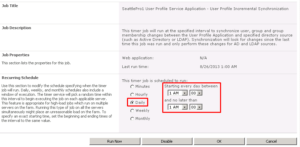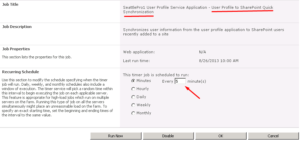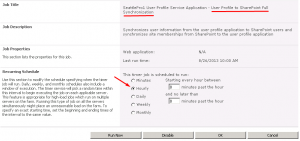Active Directory User Profiles and SharePoint 2010/2013 Timer Jobs

There are several timer jobs related to the User Profile Synchronization (UPS) service that control the behavior of user profile synchronization from Active Directory to SharePoint. As a best practice, I do not recommend changing any of the settings in the timer jobs, unless you really know what you are doing, because it can potentially have some serious impact on the performance of your SharePoint environment. You can, however, run a timer job manually to update the information rather than waiting for the next scheduled interval when the timer job will run.
You can access the timer job definitions in SharePoint 2010 or in SharePoint 2013 by going to Central Administration -> Monitoring -> Timer Jobs -> Review job definitions. The timer jobs are listed as your UPS service application name followed by the name of the timer job. For example, if the name of the UPS service application is SeattlePro User Profile Service Application then the name of the timer job User Profile Change Job will be listed as “SeattlePro User Profile Service Application – User Profile Change Job.”
NOTE: The screen shots in this article are from SharePoint 2010 but the content displayed on the screen is essentially the same for both SharePoint 2010 and SharePoint 2013.
By default, the UPS synchronizes the user profiles from Active Directory daily at 1:00AM. This is an incremental synchronization so only the users, group and group membership that has changed since the last synchronization will be synchronized. You can change the frequency of this synchronization if necessary but, as I mentioned earlier, I do not recommend changing timer jobs frequency without understanding the potential impact. The timer job responsible for this update is called User Profile Incremental Synchronization.
WARNING! Do not change anything in the timer job called System Job to Manage User Profile Synchronization. It serves a very different purpose and is not responsible for changing the user profile incremental synchronization.
If you want to run the timer job manually, you can click the Run Now button. This is relatively a safer option than modifying the schedule because there are lots of other timer jobs run at different intervals and without knowing the overall schedule changing one schedule can potentially affect other timer jobs and make your SharePoint environment unstable.
User Profile to SharePoint Quick Synchronization
There are two timer jobs that synchronize the user profiles to SharePoint. One does a quick synchronization of the user profile information from the user profile application (UPA) to SharePoint users that were recently added to the site. This is done every 5 minutes by the timer job called User Profile to SharePoint Quick Synchronization.
User Profile to SharePoint Full Synchronization
The other timer job is called User Profile to SharePoint Full Synchronization and it performs a full synchronization of the user information from the (UPA to the SharePoint users. It also synchronizes site memberships from SharePoint to the UPA every hour.
Changes in SharePoint 2013 UPS Timer Jobs
I have noticed some minor changes to the timer jobs in SharePoint 2013. There are two new timer jobs in SharePoint 2013 that didn’t exist in SharePoint 2010.
- Feed Cache Repopulation Job: Runs every 5 minutes and handles the repopulation of feed cache.
- User Profile to SharePoint Language And Region Synchronization: Runs every minute and synchronizes language and region information from the user profile application to SharePoint users.
Another change is the default interval for the Activity Feed Job. It runs every hour in SharePoint 2010 and every 10 minutes in SharePoint 2013.
In SharePoint 2010 the User Profile Language Synchronization Job, which runs every minute, looks for new language pack installations and makes sure that strings related to user profile service are localized properly. Frankly, it seems an overkill to be looking for a language pack every minute. In SharePoint 2013 this timer job still exists but runs every hour, instead of every minute, which seems more reasonable. However, there is a new timer job that runs every minute called User Profile to SharePoint Language And Region Synchronization. This job synchronizes language and region information from the user profile application to SharePoint users. So Microsoft has enhanced this functionality by synchronizing language and region information every minute but looking for language pack installations once an hour.
UPS Timer Jobs in SharePoint Server 2010 & 2013
Here’s a table that describes each UPS timer job and the default frequency interval when it runs. I decided to summarize both SharePoint 2010 and SharePoint 2013 timer jobs in one table because the changes are relatively minor. You can download a PDF version of this table here.
| Time Job | Description | Frequency |
| Activity Feed Cleanup Job | Cleans up pre-computed activities used in activity feeds which are older than 14 days. This job does not affect the User Profile Change Log. | Daily at 3:00AM |
| Activity Feed Job | Pre-computes activities to be shown in users’ activity feeds. | SP2010: Every hourSP2013: Every 10 minutes |
| Audience Compilation Job | Computes memberships of defined audiences. | Weekly – Saturday at 1:00 AM |
| Feed Cache Repopulation Job | Handled the repopulation of feed cache. [Not available in SP2010] | Every 5 minutes |
| My Site Suggestions Email Job | Sends out emails with colleague and keyword suggestions to people who don’t update their profile often, prompting them to update their profiles. | Monthly – 10:00 PM on the 15th |
| Social Data Maintenance Job | Aggregates social tags and ratings and cleans the social data change log. | Every hour – at the half hour mark |
| Social Rating Synchronization Job | Timer Job to synchronize rating values between Social Database and Content database. | Every hour – at the top of each hour |
| System Job to Manage User Profile Synchronization | This timer job manages provisioning, run steps and additional tasks related to User Profile Synchronization. DO NOT CHANGE the information or frequency of this job. If you need to change how often incremental synchronization is done, access the user interface through the User Profile Service admin page, and click on the “Schedule Incremental User Profile Synchronization” link under the “Synchronization” category. | Every minute |
| User Profile Change Cleanup Job | Cleans up data which is 14 days old from User Profile Change Log. | Daily at 10:00 PM |
| User Profile Change Job | Processes changes to User Profiles | Every hour |
| User Profile Incremental Synchronization | This timer job will run at the specified interval to synchronize user, group and group membership changes between the User Profile Application and specified directory source (such as Active Directory or LDAP). Synchronization will look for changes since the last time this job was run and only perform these changes for AD and LDAP sources. | Daily at 1:00 AM |
| User Profile Language Synchronization Job | Looks for new language pack installations and makes sure that strings related to user profile service are localized properly. | SP2010: Every minuteSP2013: Every hour |
| User Profile to SharePoint Full Synchronization | Synchronizes user information from the user profile application to SharePoint users and synchronizes site memberships from SharePoint to the user profile application. | Every hour – at the top of the hour |
| User Profile to SharePoint Language And Region Synchronization | Synchronizes language and region information from the user profile application to SharePoint users. [Not available in SP2010] | Every minute |
| User Profile to SharePoint Quick Synchronization | Synchronizes user information from the user profile application to SharePoint users recently added to a site. | Every 5 minutes |
Copyright ©2013 Zubair Alexander. All rights reserved.






Hello, I’m working with SharePoint 2013 and my User Profile to SharePoint Quick Synchronization takes more than 15 min. each time.
Hopefully, you have any suggestions.
Kind regards,
Helmut